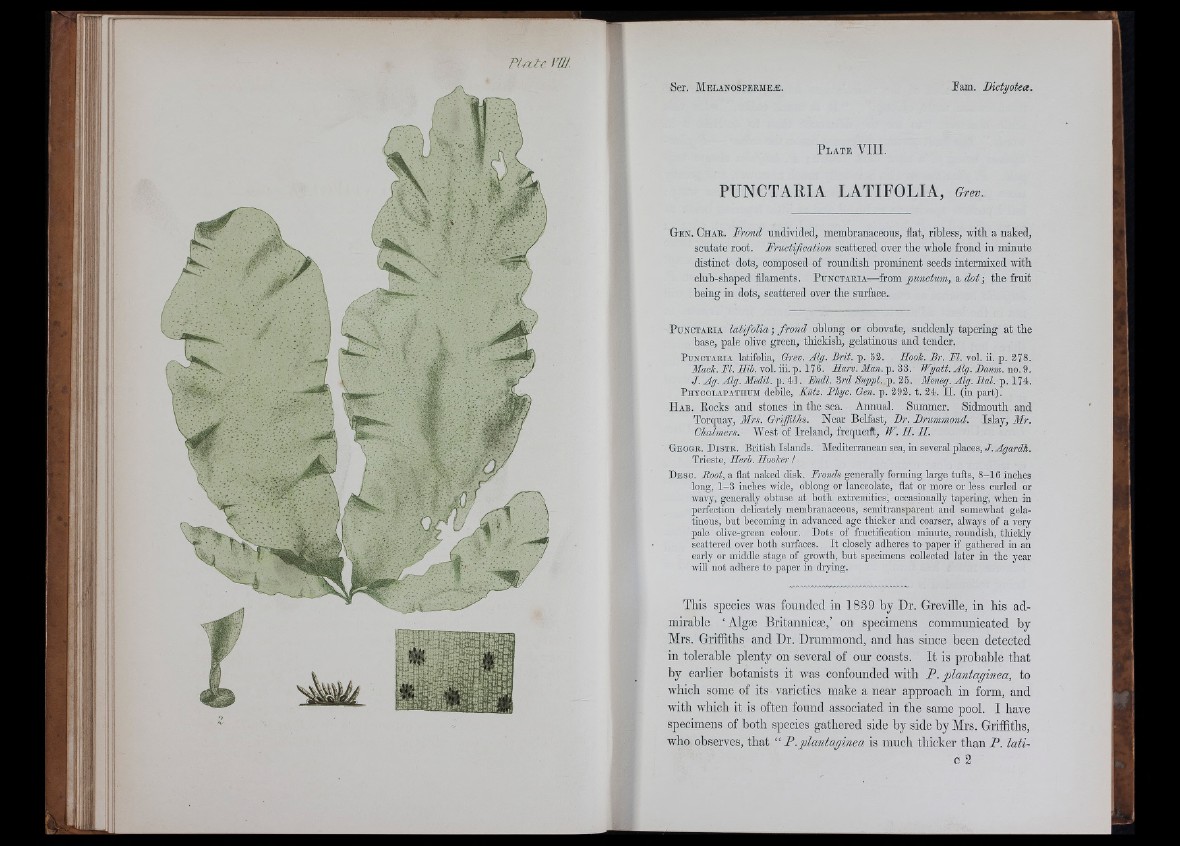
ñ a / e m .
I* S|: ■;
iiií
A e á r ñ F F j é / )
P l a t e VIII.
PUNCTARIA LATIFOLIA, Grev.
Gen. Char. Frond undivided, membranaceous, flat, ribless, with a naked,
scutate root. Frnctijication scattered over th e whole frond in minute
distinct dots, composed of roundish prominent seeds intermixed with
club-shaped filaments. P unotaria— from punctnm, a do t; th e fru it
being in dots, scattered over th e surface.
P unotaria latifolia; fro n d oblong or obovate, suddenly tapering at the
base, pale olive green, tliiokish, gelatinous and tender.
P u n o t a r ia latifolia, Grm. Alg. Brit. p. 53. Hook. Br. FI. vol. ii. p. 378.
Mack. FI. Ilib. vol. iii. p. 176. Harv. Man. p. 33. Wyatt. Alg. Damn. no. 9.
J . Ag. Alg. Medit. p. 41. Endl. 3rd Suppl. p. 25. Meneg. Alg. Ital. p. 174.
PiiYCOLAPATHUM debile, Kiitz. Pliyc. Gen. p. 392. t. 34. I I. (in part).
H ab. Eocks and stones in the sea. Annual. Summer. Sidmouth and
Torquay, Mrs. Griffiths. Near Belfast, Dr. Bnmmond. Islay, Mr.
Chalmers. West of Ireland, frequeift, W. II. II.
G e o g r . D i s t r . British Islands. Mediterranean sea, in several places,/ .
Trieste, Herb. Hooker !
D e s c . Root, a flat naked disk. Fronds generally forming large tufts, 8-16 inches
long, 1-3 inches wide, oblong or lanceolate, flat or more or less curled or
wavy, generally obtuse at both extremities, occasionally tapering, when in
perfection delicately membranaceous, semitransparent and somewTat gelatinous,
but becoming in advanced age thicker and coarser, always of a very
pale olive-green colour. Dots of fructification minute, roundish, thickly
scattered over both surfaces. I t closely adheres to paper if gathered in an
early or middle stage of growth, but specimens collected later in the year
will not adhere to paper in drying.
This species was fonnded in 1839 by Dr. Greviiie, in his ad-
mirabie ‘Aigai Britannicas,’ on specimens communicated by
Mrs. Griffiths and Dr. Drummond, and has since been detected
in toierabie plenty on several of our coasts. It is probable that
by earlier botanists it was confounded with P. plantaginea, to
which some of its varieties make a near approach in form, and
with which it is often found associated in the same pool. I have
specimens of both species gathered side by side by Mrs. Griffiths,
who observes, that “ P.planlagitiea is much tldcker than P. latic
2